Part of a series of articles titled Chaco Collections—Paleontology.
Previous: Petrified Tree stump
Next: Ripples and Bivalves
Article

NPS photo.
Inoceramids are bivalves related to living clams and mussels and are one of the most common marine fossils of the Late Cretaceous. Large, diverse groups of Inoceramids lived in shallow waters and were epifaunal, covering the muddy seafloor like a carpet. This family of bivalve diversified rapidly during the Cenomanian and Turonian ages, branching out to more than 70 species over the course of just about 11 million years. Species ranged from a few centimeters to two meters (1-6.5 feet) in length. Their success continued for another 34 million years until the end of the Cretaceous period when they went extinct along with several other taxa.

NPS photo.
Footnotes linked to the 3D model:
Footnotes
Part of a series of articles titled Chaco Collections—Paleontology.
Previous: Petrified Tree stump
Next: Ripples and Bivalves
Last updated: April 30, 2021